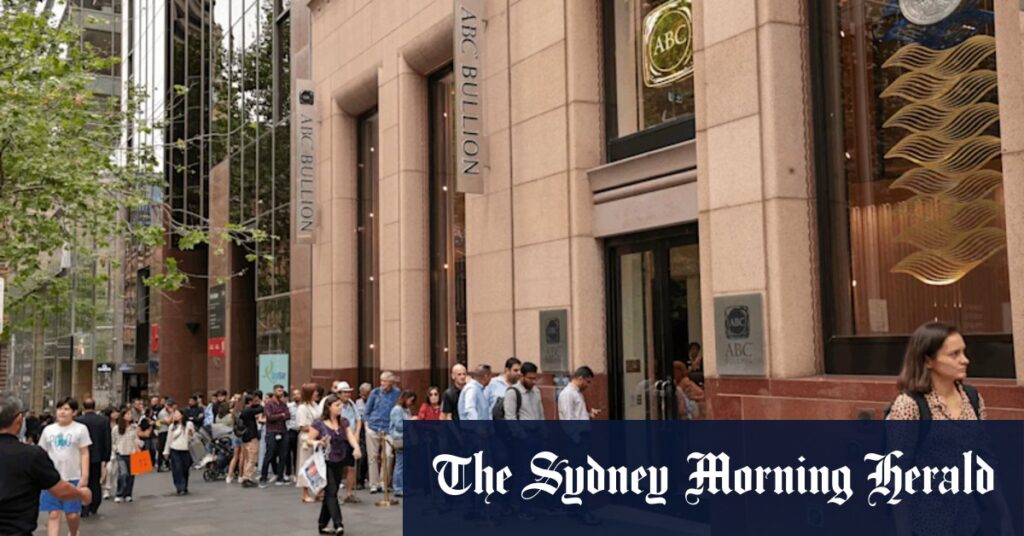
Australians are queueing up to buy gold as the demand for the precious metal surges amidst global uncertainty and low-interest rates, driving its price to unprecedented highs. Experts now predict that jewelry and other gold-reliant products will become more expensive.
On Thursday, the spot price of gold was approximately $US4020 ($6095) an ounce, nearing its record high of $US4059.31 an ounce. This surge follows the recent US government shutdown, which has boosted demand for safe-haven investments. Bullion has been on a rally for eight weeks, beginning its ascent from a price of $US3290 at the end of July.
Factors Driving the Gold Surge
Gold was trading below $US2000 two years ago, but it has jumped more than 54% this year alone. Investors view it as a safe asset amid geopolitical instability and low interest rates. Economists attribute this rise to several factors, including the US tariff regime and conflicts in the Middle East and between Russia and Ukraine.
Central banks around the world increasing their gold holdings have also contributed to the rising prices. The US government shutdown has added a layer of uncertainty, further fueling interest in gold.
Shane Oliver, chief economist and head of investment strategy at AMP, notes that gold’s surge has created a FOMO (fear of missing out) effect.
Demand for Gold in Australia
According to Jordan Eliseo, general manager of ABC Bullion Australia, demand is so strong that queues are often seen outside the company’s Sydney store on Martin Place. Similar scenes have been reported at the Perth Mint.
“It’s just extraordinary,” Eliseo remarked. He noted that ABC’s 10-gram bar, priced around $2000, has been particularly popular.
Eliseo also mentioned a significant increase in demand for programs like a direct debit option, allowing customers to invest in gold at $50 a month. “It’s gone up by a factor of five in the last 12 months,” he said, highlighting its appeal to those without substantial capital.
Investment in gold through exchange-traded funds (ETFs) has also seen a dramatic rise. NAB reported a 125% increase in customers trading in Australian gold ETFs from 2024 to 2025.
Who is Buying Gold?
Eliseo observed a diverse range of investors, with account openings to buy gold tripling over the past month. “You’re seeing mum-and-dad investors, younger Australians starting their wealth journey, and a significant surge from self-funded retirees,” he said.
Impact on Jewelry and Electronics
Allan Trench, a professor of mineral and energy economics at the University of Western Australia, stated that the skyrocketing price of gold would make products relying on it more expensive.
“The cost of inputs has gone up, therefore the price of goods that use it will go up,” Trench explained.
Global gold demand reached 4975 tonnes in 2024, with jewelry accounting for about 2000 tonnes. Gold is also used in electronics, requiring about 326 tonnes, and in other industrial applications.
Trench highlighted that while jewelry uses significant amounts of gold, electronics require much smaller quantities. “In the context of an iPhone, it might be a microgram of gold,” he said, noting that jewelry is more affected by gold price increases.
“Jewelry is a status symbol. As a luxury good, its higher price adds to its appeal,” Trench added.
He predicts that if the trend continues, jewelry makers might produce ranges with lower gold purities to maintain affordability.
Australia’s Position in the Gold Market
As a gold-rich nation, Australia stands to benefit from these high prices. However, Trench warns that this could impact the country’s energy transition. “It could take away effort from other metals that can do wonderful things for us,” he cautioned.
With the domestic capacity for drilling and exploration already focused heavily on gold, further increases in gold prices could shift even more resources towards gold production.
As the situation unfolds, Australians and global investors alike will be closely watching the gold market, assessing its implications for the broader economy and individual investment strategies.





